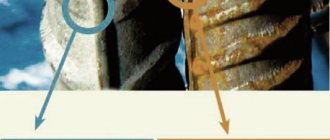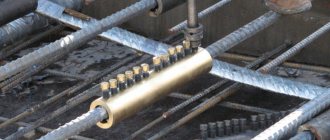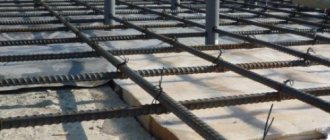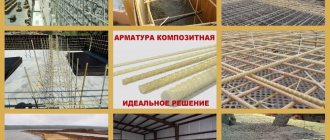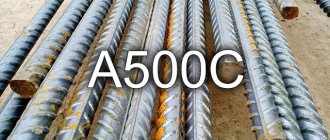a brief description of
Bath welding is a method of welding metal products that uses a U-shaped fixture. It has several names - trays or bracket plates for welding reinforcement. This formed the basis for the name of this welding method. Parts of the reinforcement are immersed in the bracket-tub, molten steel fills it to the brim. After this, the metal hardens and forms a seam with high strength.
To prevent molten steel from flowing out from the ends of the bath, restrictive elements are placed. And at the end of the welding process, the pools are combined with reinforcement and molten steel. There are removable linings that are made of copper, its alloys, ceramics, and graphite. These options are intended for repeated use.
Bath welding of reinforcement can be carried out using one or more electrodes. This welding method allows you to weld metal elements in any position in space, except for the ceiling. The size of the lining must be larger than the diameter parameters of the reinforcement. There should be at least 15 mm from the edges of the bath to the element being welded.
If the products are in a horizontal position, then to create a bath, a steel plate is welded to the connecting reinforcing bars in the area of their junction. When welding rods that are in a vertical position, stamped steel forms are used. They are welded to the end area of the product, which is located below.
Requirements for bath connection technology
Let's start with the fact that bath welding of reinforcement is a process in which, in addition to electrodes and a welding machine, a special device with a U-shaped cross-section, made of low-alloy steel by stamping, is used. This is the first.
Secondly, the dimensions of the bath are determined by the diameters of the joining fittings. The only standard value is the thickness of the steel used to make the bath, equal to 6-8 mm. Let’s make a reservation right away that the device is disposable. When welding is completed, it remains at the site where the reinforcement is joined, as an integral part of the connection. Thus, the bath further strengthens the joint.
Steel inverter molds
It should be added that in addition to steel inverter molds, when welding two reinforcing rods, copper or graphite are used. Both options are reusable, that is, after finishing the work, the baths are removed, cleaned, and can be used again at another joint. This is a big plus, but these forms have a big minus - the high price. Therefore, most often builders use steel forms.
The third requirement is that the two ends of the reinforcement are joined along one axis with a tolerance within half the diameter of the rods. The gap between the ends is no more than 1.5 times the diameter of the reinforcement. In this case, bath welding of reinforcement can be used both at a horizontally located joint and at a vertically located one.
Attention! In the latter case, a steel limiter is added to the bath, which is welded to the mold from below. It is this that prevents the molten metal from flowing out.
Fourth, rods with a diameter of 20-100 mm can be connected using this method if manual welding is used.
The fifth requirement concerns welding methods. There are three positions here:
- manual,
- automatic (special welding equipment is used with automatic electrode supply and movement of the electrode holder),
- semi-automatic (movement of the holder is manual, electrode supply is automatic).
Features and nuances of the welding process
Welding reinforcement using the hot tub method has several additional features that must be considered before starting work. This technology is considered a simple process, but still, if you want to get a high-quality and durable connection, you should prepare carefully.
Bath welding has the following features:
- The welding process must be carried out continuously. This makes a huge difference in achieving an even melt. The fact is that the temperature indicators of some types of metals are quite high; it takes a lot of time to warm up. Due to the fact that welding work is carried out in a continuous mode, the steel melts much faster.
- Bubbles of slag and protective gas form on the surface of the metal product. To let them out, you need to make a hole in the bath. But still, slag formations are not considered foreign components; they protect the seams from oxidation.
- The technology of bath welding of reinforcement involves the appearance of a protective crust on the joint surface. Usually its formation indicates compliance with all the rules of the welding process.
- Immediately after welding is completed, there is no need to peel off the protective crust; you need to wait until the molten metal hardens. In the meantime, while the part is hot, you can lightly tap it on all sides, this will eliminate the increased stress.
- When welding, the electrode should not be held motionless at the joint area. Beginners think that this will ensure that thermal energy can independently disperse over the surface of the product and the steel will melt evenly. During the process, the movements must be consistent, and at the same time the welder must capture unmelted edges.
- The workflow speed should not be too slow or too fast.
- If the welder does everything too quickly during welding, he will not be able to melt the metal to the required temperature, and the joint itself will be of poor quality.
- If the welder is slow, he will not melt the steel evenly. As a result, it will be distributed in the bath so that the finished seam will turn out to be of poor quality. The optimal welding speed is indicated in GOST standards.
Advantages
Pool welding is a simple and easy method of connecting sections of metal structures. This technology is used in many areas of production; it allows you to work with different types of metal.
Bath welding of reinforcement and columns has a number of advantages:
- this method can be used for fixed parts of metal structures. There is no need to rotate and move them to create a strong connection over the entire surface;
- during the melt, uniform rather than spot heating of the rods occurs;
- examination of the seam can be performed using available methods, for example, using gamma-ray diagnostics;
- Conventional equipment can be used for the work process;
- welding using this method allows you to obtain a strong and high-quality connection;
- baths for welding reinforcement prevent the spreading of molten material, they form a neat and even seam;
- minimal costs for consumables;
- maximum convenience that facilitates welding. And the steel form serves as an additional stiffening rib;
- You can quite simply select the shapes to match the dimensions of the rod. They are available in a wide range.
State standards
For this construction process, a GOST was developed called “Joints of welded reinforcement and embedded products of reinforced concrete structures.” The standard was introduced on July 1, 1992 under the number 14098-91.
Bath welding is a reliable and commonly used method. A distinctive feature of this process from all other types of welding is its continuity, which is very important for uniform melting. Thanks to this process, the metal melts much faster.
The welding method is used in the construction of various massive structures and buildings. The seam created using this welding is capable of withstanding moving loads without destroying the integrity of the structure and meets the requirements of GOST. If conventional butt welding is carried out, it can lead to failure of the joint near the seam, thus significantly degrading the quality of the weld.
Flaws
But it is still worth remembering that welding reinforcement using the hot tub method is not just an easy method of obtaining a strong connection; this process has some disadvantages that should be taken into account when carrying out welding work.
Among the negative aspects are:
- When carrying out the welding process, continuity of work must be observed;
- you need to ensure that the heating covers the entire contact area;
- This welding method requires professional training;
- usually welding pools are used only once, they are not intended for repeated use;
- The preparatory stage must be followed, and this is an additional time investment.
Important! If the required temperature conditions are not observed during the welding process. If cooled too quickly, too much slag may form.
Equipment used
We have looked at what it is - hot tub welding, but you still need to know what equipment should be used during this process. This is an important condition on which the quality and strength of the welded joint depends.
Typically, the following elements are used during bath welding:
- Welding machine. This element reduces the voltage to 220 volts and produces direct current with great strength. It is called a welding inverter; it has a full range of functions and modes. Currently, small-sized devices are being produced that can be used at home.
- Overlay brackets for welding reinforcement. These products should be selected in accordance with the type of connection and the nature of the elements being welded. For horizontal ones, it is recommended to use options such as C14-Mn, C15-Pc, C16-Mo.
- To protect the molten metal in the weld pool, in some situations it may be necessary to create an environment of inert gas; this is usually required by the quality of the materials being welded. For these purposes, it is recommended to use small cylinders with inert gas, which are commercially available.
- Consumable type electrodes. They can have different coatings made of aluminum, copper, steel and other alloys. For ordinary work, rods of the MP-3 or ANO brands are suitable; their diameter should be within 2-4 mm. These consumables can always be found on sale. But only SSSI rods are suitable for critical equipment.
- Welder protective mask. The most suitable option for welding work would be a product that is mounted on the head. Additionally, you need clothing and gloves made of protective material. Products must be protected from ultraviolet rays and splashes of molten metal.
How is bath welding carried out?
The technology for bath welding of reinforcement and columns consists of several stages. During the first step, all materials and parts to be welded are prepared. And in the next stage, the main welding work is carried out.
There are a few things you should do when preparing:
- Cleaning the ends of the reinforcing bars with a wire brush until shiny. During this stage, it is worth removing all areas with rust, dirt, paint and other types of contaminants. All this can deteriorate the quality of the connection, making it brittle and weak. The clearing size at each end should be at least 3 cm;
- an inverter mold must be spot welded to the lower planes of the joining rods. It will serve as a container for accumulating molten steel.
After this, you can begin welding the columns and fittings. The electrode needs to be brought to the end of one of the rods and begin to melt it. The consumable needs to be moved over the entire area of the end - movements can be circular or from side to side. Afterwards you can move to the opposite end of the reinforcement being welded. Actions should be carried out one at a time until the bath is completely filled with molten metal.
It is worth noting! All actions and movements during the welding process should be light, because melting occurs at high currents. For example, if electrodes with a diameter of 7-8 mm are used, then a current of 400-450 amperes should be applied to them.
Welding must continue until the molten metal covers the rods being connected. After this, it is recommended to carry out the final steps correctly - you need to once again evenly heat the metal in the weld pool, this is necessary for its uniform cooling. Next, the electrode is rotated between the ends of the reinforcement being connected, but this should not be done too much.
Bath welding process is a popular method that is used in various industries. It allows you to get a strong, high-quality and even connection, and this is achieved through the use of pad brackets for bath welding, also these elements are called baths. They also prevent splashing and flow of molten material from the welding zone. But still, before carrying out work, it is worth considering its important features and principles.
Weld pool technology
The connection of reinforcing bars and other solid elements is carried out as follows:
- They are installed in the conductor with some clearance.
- Limit the space between the workpieces on 3 sides with special pads or a U-shaped bracket.
- The ends are heated with a consumable electrode until they liquefy. They must be constantly maintained in this condition, moving the tool from one product to another. Gradually, the gap between them will be filled with molten metal.
We recommend reading: How to pressure cook
There are bath and bath-seam technologies. In the second case, the overlay is welded to the workpieces using flank seams. As a result, it strengthens the joint, absorbing part of the load.
Using one electrode
1 consumable is not enough to fill the weld pool. So, to connect reinforcement with a diameter of 28 mm, 3 electrodes with a thickness of 4 (mm) are required.
Since it is undesirable to interrupt work, consumables have to be changed quickly (the permissible pause is 3-5 seconds).
Beginner welders may not be able to cope with this task.
Single-electrode welding.
Multi-electrode welding
It is easier to form a seam simultaneously with several consumables - the so-called. comb of electrodes. Before starting work, they are attached to a steel plate with tacks so that part of it remains free. This shank is placed in an electrode holder.
After completing the weld, the cinders are beaten off and the plate is reused.
The execution technique does not differ from the 1-electrode method.
Three-electrode pool welding.
